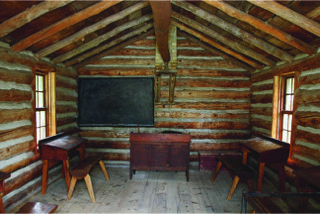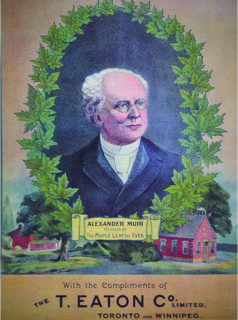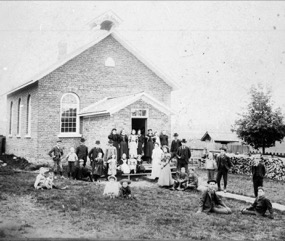by Douglas Phillips
It is a bright sunny autumn morning, with a touch of frost in the air. Time for a trip to the country to see the fall colours, take in a country fair, visit some antique shops and have a leisurely stroll through a village.
Forget the expressways and dual-lane highways and decide, instead, to explore the rural roads that wind through the countryside passing the golden wheat fields and fall harvest. Not much has changed in rural Ontario, with its century farmhouses and wooden barns. The church spire in the distance catches the sunlight, and as you drive along the lanes, the maple trees show off their splendid colours in all their glorious shades of red, gold and orange.
At the crossroad, one can still find a one-room schoolhouse, now a local community centre. A hundred years ago, children would have been playing on the grass waiting for the teacher to ring the school bell to start the day’s lessons. There were no yellow school buses in those days, and children often had to walk many miles in all kinds of weather or hitch a ride on a farmer’s horse and wagon.
When the school day began, the teacher rang the bell, and the children lined up; boys at the boys’ door and girls in front of their door; grade one first and grade eight last. Standing by their desk the day usually started with the Lord’s Prayer, then facing the Union Jack and the portrait of King Edward VII the class sang God save the King followed by The Maple Leaf Forever.
When the lessons began, it was a challenge for teachers to work with all eight grades. Older children often helped the younger ones. The three “R’s” Reading, Writing, and Arithmetic were the basis of education, first using wooden framed slates with slate pencils, and later, paper and straight pens that students dipped in ink that blotted and stained desktops. Geography and history lessons were based on the British Empire, and a large map hung on the wall with the countries belonging to Britain painted in red. Friday was home economics for the girls who practiced sewing and boys made small bookshelves with hand tools.
The only source of heat was a wood stove with a large overhead pipe that ran the length of the classroom. In winter, older boys would fetch the wood from the outside woodpile, supplied by the local farmers. Lighting came from the large single-paned windows that opened to give a cross breeze in the warmer weather.
Most one-room school houses we see today are all quite similar, built of local material from plans and guide lines published by the Ontario Department of Education on land donated by local landowners.
In early classroom photographs, standing behind the children was the teacher, usually a woman. Most rural teachers were single females as this was a way to save money, although their salaries were much lower than those of male teachers. The young women boarded with a local family and were expected to set high moral standards for their young students. In the Ontario School Act of 1896, it stated that every teacher should diligently teach all subjects in the public-school course while upholding Christian values and love of country. The teacher was expected to attend church on Sundays, be benevolent, sober, and temperate, and possess all other virtues. For those who fit in with the community, the teacher had a degree of status. Somebody new at a social function attracted many a young man, and in some school districts, the turnover of teachers was high as matrimony claimed many who became farmer’s wives. One community had as many as eight former teachers living in it.
The School Trustees oversaw the running of the school and approved the repairs and supplies. They were mainly local farmers who overlooked every cent spent, and when the money ran out from local taxes and government grants, they undertook the work themselves repairing roofs, painting and mowing the yard. Meetings were held with teachers to discuss the students’ progress and new teaching methods. These methods sometimes met with resistance from trustees whose own schooling was often limited. This is illustrated in Robert Harris 1885 painting “A meeting of the school trustees” when Kate Henderson, a Prince Edward Island teacher proposed new teaching methods.
In the early pioneer days of Upper Canada, log schools, in some districts, were built by the settlers. Teachers had no formal training, and some were disabled military men with war wounds who could not work in the fields. There were no official textbooks and lessons were hit-and-miss. Schooling was not mandatory in the backwoods, and children were required to work alongside their parents on the farm. If they were fortunate, they attended a few days at school each month.
Changes came in 1844 when Egerton Ryerson was named Upper Canada’s first superintendent of schools. He then spent a year in Europe looking at the school system there. On his return, he made recommendations to expand the school curriculum, which included grammar, geography, science, and arithmetic. Ryerson also wanted to incorporate music, drawing, history, civics, nature study, physical training and importantly, hygiene. He proposed free education for everyone but this needed to be supported by taxes. Many agreed with him, but it was not a popular idea at the time as money was scarce especially in rural areas and in depression times.
However, by 1871 Ontario had a free universal education, and this was adopted by the Western provinces as they joined Confederation. By the end of the century, inspectors started on their rounds, and standard textbooks or readers appeared. The pattern of the present school year was established. It was compulsory for children aged 7 to 12 to attend school for a minimum of four months a year, but as schools were usually open for eleven months, many children attended school longer. By 1919 the age for compulsory attendance was raised to age 16.
As more people emigrated to Canada between 1841 and 1871 and then again in 1911, many additional one-room schools were built. Some operated well into the 1960s and early 1970s. Today many have undergone renovations, and some are now used as private schools.
Living History Schoolhouses
Historic Zion Schoolhouse c1869, built by the farming community of L’Amoreaux, North York. Closed 1955. Open as a museum at 1091 Finch Avenue East, Toronto, ON M2J 2X3 Phone: 416-395-7435
The Old Britannia Schoolhouse c1852, served the Township of Toronto until 1955, Hurontario Street, Mississauga.
Now open as a museum: 5576 Hurontario St, Mississauga, ON L5R 1C6 Phone: (905) 890-1010
Fanshawe Pioneer Village tells the story of rural communities in Middlesex County from 1820 to 1920 and the founding and development of the City of London up to 1840. Fanshawe Pioneer Village is located inside Fanshawe Conservation Area, 1424 Clarke Road in London, Ontario. Visit their website: http://fanshawepioneervillage.
Watch Heritage Minutes, Historica Canada for
“A meeting of the School Trustees” video: www.historicacanada.ca/
Thanks to Silver Creek Antiques, Port Perry, for the schoolhouse books and background info:www.silvercreekantiques.








